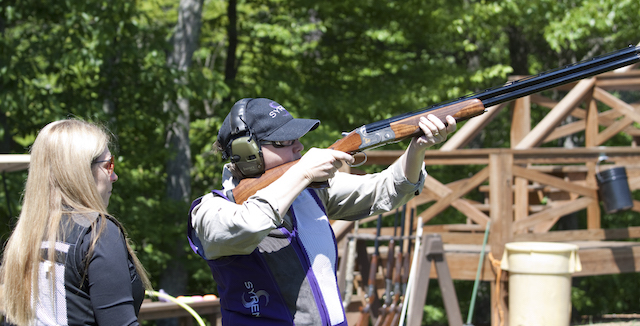This year, most of the women attending our annual Delta Waterfowl Women’s Education day in Kenai, Alaska, were experienced big-game hunters who had never hunted waterfowl. Because the differences between shooting a rifle and shooting a shotgun are significant, we focused our firearms training on making the switch. A typical big-game hunter may only press the trigger once or twice in a season. The rifle is designed for accuracy, to hit a precise point at long ranges. A bird hunter is going to shoot a great deal more, and the shotgun is made to shoot a spread of shot at a moving target at closer ranges, faster. Instead of a scope or iron sights, with a shotgun, the shooter’s eye is the rear sight and she is looking at the target, not the crosshairs. It’s time to get ready for shotgun hunting.
We focused on 5 shotgun essentials for duck hunters that help the beginner avoid frustration and bruises.
It would be sweet if every shotgun worked for every person and every hunt. A firearm is said to be a tool, but selecting a shotgun is more like selecting a car than a hammer. The type of action, gauge, weight and barrel length are all considerations. While a 20-gauge over-and-under with 28-inch barrels weighing less than 7 pounds may be a good place to start for a hunter who weighs 110 to 130 pounds, the “feel” of a shotgun has a difficult-to-quantify, yet intrinsic, value. A shotgun becomes an extension of the gunner, making it worthwhile to “test drive” several different types.

University of Maryland Trap and Skeet Coach Anne Mauro coaches Barbara Baird on shotgunning skills. Baird is shooting a Syren Tempio. (Jason Baird photo)
Most factory stocks are too long for women. A shorter stock can bring a shooter’s hand and face in closer proximity to each other, which gives her better control of the gun. A large gap between the thumb and face makes for less control of the gun. The best way to test to see if a gun fits is, when wearing the heaviest gear you’ll wear hunting, place the buttplate in the crease of the elbow, the front pad of the trigger finger should be centered on the trigger. A good gun fit helps a shooter achieve the economy of movement necessary to quickly mount and fire accurately, in comfort. For me, it was as simple as cutting an inch off all my shotguns at home, but complete modifications by a professional are worth the money spent if they result in good gun fits.
The most critical factor for hitting targets with a shotgun is keeping your head down on the stock. One way to determine where you are looking is to mount the shotgun in front of a mirror and see that your eye appears perfectly over the bead. Then, practice that mount over and over. If my cheek stays firmly to the stock, the gun points and shoots where I was looking. In the field, learning how to lead birds is important. Practicing a “sustained lead” or “pulling through the shot” does not happen at the thinking-level as much as instinctually. My favorite example of leading is Robert Ruark’s explanation of trying to hit someone with water from hose while that person is running – somehow we were born knowing how to soak a sibling!
Rifle shooters either make on location sight corrections or hold their guns lower or higher for different ranges. They often have time to get into the best position for the shot. A shotgunner has a split second to mount the gun, pick out the target, lead the bird, press the trigger and remember not to stop the gun. Learning the pattern of any given shotgun with any given load requires shooting at a patterning board. Selecting a choke catered to the load, game and distances will account for more clean kills. Automatic ejectors, camouflaged barrels, cheek protectors, recoil pad and sling are all optional. The right choke and load are essential.
Trap and skeet shooting are games that relate to the field, but they have their own un-field-like rules. In both sports, shooting occurs from mounted positions. In the field, there is seldom a chance to get into perfect form. As it happened with me, I used a different gun for trap, a different gun for skeet and a different gun for hunting. On the range I wear a proper vest and shoot lead shot. If I showed up on Sundays in chest waders and my field gun, I might have done more toward my cause. But I don’t. I learned the hard way, making my errors in the field. One of the best things a waterfowl hunter can do is shoot from situations that simulate hunting. This means wearing the clothes and shooting the gun and load (steel shot) that will be used in the field. Trap and skeet practice did help me develop the muscles and form required, but practicing simulated field shooting did more.
Rifle shooting is said to be a science and wing shooting is said to be an art. It would be impossible to simulate the miserable weather, smell of the swamp and exhaustion I experienced my first day duck hunting. Add a gun dog, a call and a flock of pintail cupping into decoys, and it’s easy to see why practice is necessary. One of the reasons wing shooting is considered an art may be because there’s no perfection in it. Like art, it is pursued with heart and the sky is the limit.
Christine Cunningham is a lifelong Alaskan, author and outdoor columnist known for her contributions to outdoor magazines and her commitment to creating opportunities for women to connect and share their stories. Her first book, “Women Hunting Alaska,” profiles some of Alaska’s most outstanding female hunters. View all posts by Christine Cunningham